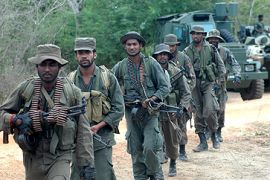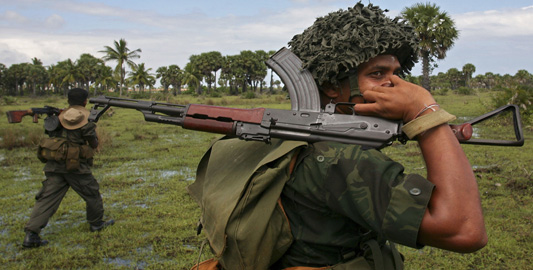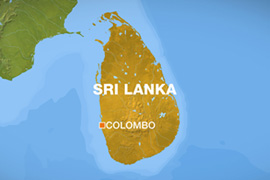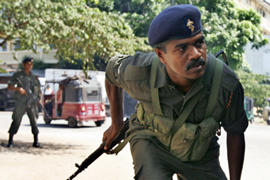Sri Lanka crisis set to worsen
An analysis on the ethnic strife as a 2002 truce officially ends on January 16.

 |
| As the civil war intensifies, another year of bloodshed dawns on Sri Lanka [GALLO/GETTY] |
The Sri Lankan government’s decision to dump the Norwegian-brokered and internationally-backed Cease-fire Agreement (CFA) with the Liberation Tigers of Tamil Eelam (LTTE) can only result in more bloodshed in a country where ethnic strife has raged for 25 years.
A formal declaration of war, if and when it happens, will only lead to more misery.
Although the CFA of February 2002 had more or less collapsed in recent years, the reluctance of the two parties to formally jettison it gave rise to hope that there was still something left to build on.
But the Sri Lankan military’s success last year in driving away the LTTE from the country’s eastern province, after a gap of some 15 years, gave the government new-found confidence.
Dominant sections in the administration of Mahinda Rajapaksa, the Sri Lankan president, concluded that it was a matter of time before they could choke the LTTE in its long-established stronghold in the island’s north.
And they did not want the CFA and its provisions aimed at preventing war to stand in the way.
Axing the CFA
However, vanquishing the LTTE is not going to be easy. The LTTE – which remains one of the best organised insurgent groups in the world despite its recent military reverses – has always displayed a remarkable ability to bounce back from the brink.
Although it is now facing one of its bleakest moments, there are no indications so far that says the LTTE is about to give up.
In axing the CFA, Sri Lanka has seriously dented the Western support it enjoyed in the war against the Tamil Tigers.
 |
| The LTTE wants an independent state in the north and northeast of the island |
Although there was considerable dismay over the massive human rights violations blamed on the military and anti-LTTE Tamil groups allied to it, the world at large remained largely sympathetic to Colombo.
Sri Lanka was further emboldened by the fact that since 2005, the LTTE had been banned in Canada as well as the 27-nation European Union, in addition to earlier bans by India, the US, Britain and Malaysia.
The Tigers, who maintain overt and covert presence almost all over the world, are also under watch in countries where they have not been formally declared a terrorist organisation.
International disapproval of Colombo’s move is already evident.
The US has pledged to end its military backing although some Sri Lankan officials say critical supplies will not cease.
Canada, home to the largest Sri Lankan Tamil population outside the country, has voiced distress. So has the European Union. The Nordic countries, which at one time provided monitors to oversee the CFA, have warned of dark days ahead.
India, Sri Lanka’s biggest and most important neighbour, made mildly critical remarks, reiterating that there could be no military solution to the conflict in which over 65,000 were killed and hundreds of thousands displaced since 1983.
Intractable
Sri Lanka has today become as intractable as the Middle East. But without the oil, it receives much less international attention. A once simple, though bloody Tamil-Sinhala fight, with only India taking a keen interest, has now assumed menacing proportions and involves several domestic and foreign actors.
| Related | ||
|
|
The government remains locked in conflict against the LTTE, while the latter itself is engaged in a vicious war against a faction that broke away in 2004. The breakaway outfit (whose leader is now in custody in Britain) has further split into two, each trying to outdo the other with the gun.
Meanwhile, in the country’s multi-racial eastern province, there is growing radicalisation among sections of Muslims, who speak Tamil but consider themselves a distinct minority.
The two dominant political parties – President Rajapaksa’s Sri Lanka Freedom Party and the main opposition United National Party – refuse to engage each other to build a pan-Sinhala consensus so vital to prepare a nationally acceptable power sharing formula to appease the minorities.
And to make things more difficult, some Sinhalese Buddhist groups remain opposed to any federal form of governance that non-LTTE Tamils clamour for.
Decades of war has begun to take a toll on the country’s social fabric. International mediators, who in 2002 thought they would be able to bring peace, have realised what India has known all along: If the conflict gets easily resolved, it will indeed be a miracle.
Elusive reconciliation
Why does peace elude Sri Lanka? Why did the killer tsunami that helped end a raging conflict in Indonesia’s Ache province fail in this Indian Ocean island country? Why does and how long can the LTTE keep fighting? Can they survive the government’s determined bid to eliminate it?
Surprisingly, the answers are not hard to find. Ever since the Tamil campaign for an independent state comprising Sri Lanka’s northeast began to gather force in 1983, the LTTE believed it could win – one day.
Once it became the dominant player by decimating other Tamil groups and then taking on the Indian peace keeping troops deployed in the northeast, it became the de facto ruler of the region, particularly Jaffna, the Tamil heartland.
After Sri Lanka seized Jaffna in December 1995, the LTTE hit back viciously, handing the military one setback after another until the government brought in Norway as a facilitator to hold talks with the Tigers. This led to the CFA.
Contrary to public knowledge, the Indian establishment played a key role in the drafting of the agreement. This is a key reason why India remained solidly supportive of Norway’s role in Sri Lanka.
Détente
The cease-fire years undoubtedly brought unprecedented peace to a region ravaged by war, but at a cost. Its biggest success was that it halted fighting between the government and the LTTE, saving an estimated 10,000 lives in the first three years at least. But in the very nature of the agreement’s birth lay the seeds that ultimately tore it apart.
The truce justified the LTTE’s de facto control of large parts of the northeast even as the Tigers hunted down rival Tamils and, later, members of the Sri Lankan intelligence establishment.
Norway’s failure to take into confidence Chandrika Kumaratunga, the then president, led her to undermine Ranil Wickremesinghe, the prime minister who had signed the pact. The yawning gap of perception between the LTTE and Colombo over the way forward could not be narrowed by the talks the two sides held in foreign countries, with Norway playing the referee.
Three significant developments took place in 2003-04 that sealed the CFA’s fate. First, the LTTE walked out of the peace talks, citing Washington’s refusal to invite it to an international donors meet on Sri Lanka.
LTTE divide
In March 2004, an unprecedented split took place in the LTTE when Karuna, its eastern regional commander, broke away along with thousands of guerrillas. The next month, Wickremesinghe lost elections and the new government began to team up with the Karuna faction to snipe at the LTTE.
 |
| The government now wants to take on the LTTE in the north [REUTERS] |
The LTTE’s assassination of Foreign Minister Lakshman Kadirgamar in August 2005 after one of its senior commanders was similarly killed blew the fuse. Norway, which by then was being accused of favouring the LTTE, took up the matter with Velupillai Prabhakaran, the group’s chief.
In November, Rajapaksa, seen as a hardliner belonging to the majority Sinhalese community, was elected president. After giving the new president an year’s time to resolve the ethnic crisis, the LTTE began to target Sri Lankan troops.
The LTTE attempted in 2006 to assassinate two high profile targets, Sarath Fonseka, the army chief, and Gotabhaya Rajapaksa, the defence secretary and the president’s younger brother who was spearheading the war against the LTTE.
The government was furious. It pounded LTTE areas with relentless air and artillery attacks, effectively preventing the group from converging in large numbers.
The military and anti-LTTE Tamil groups were also given the carte blanche to kill LTTE spies. In much of 2006, abductions and random killings of Tamils became commonplace, raising concerns in many capitals.
Using valuable help provided by the Karuna faction, Sri Lankan forces seized one LTTE base after another in the eastern province. Although the LTTE responded by unleashing its nascent air wing that hit some vital targets and injected a new element to the conflict, Colombo persisted.
In November 2007, government troops killed S.P.Tamilchelvan, a Prabhakaran confidante and chief of the LTTE’s political wing. And early this month, they also killed “Colonel” Charles, its military intelligence chief. Rajapaksa, the defence secretary, has vowed to kill Prabhakaran too.
No middle ground
There is no meeting ground as of today between the LTTE and the Sri Lankan state.
The government now wants to take on the LTTE in the north, where they have held sway for decades. Colombo believes it has had enough of Western homilies on human rights and that the time has finally come to give a knockout blow to the LTTE. It also thinks that talking to the group will not help.
Sinhalese nationalists within the government and outside are also against giving any concessions to the LTTE and the Tamils that would weaken the state’s unitary character.
Although the LTTE is cornered, it is far from finished. It may have lost territory in the east and closed down its offices in the north to escape aerial bombings, but it remains a potent military force.
If Sri Lankan forces storm LTTE areas in the north, they are sure to encounter stiff resistance. And if the troops recapture territory, spread over four of the north’s five districts, the Tigers will go back to guerrilla war.
In any case, the LTTE is not interested in any negotiated settlement. Having waged war for a quarter century for a Tamil state, it will be near impossible for Prabhakaran to settle for anything less unless there is an attractive alternative package.
Colombo, on its part, is the least interested in satisfying the LTTE. It is more interested in killing Prabhakaran.
That will not be easy, though. There is no credible evidence that Prabhakaran was seriously injured or killed by the Sri Lankan air force in November last year. A man who has seen many dramatic ups and downs since he fled his home in 1973 while in his teens is not going to give up, having come thus far.
For sure, the year ahead would be an eventful one for Sri Lanka.
M.R. Narayan Swamy is Deputy Editor at IANS news agency based in New Delhi. He is the author of two books on the Tamil separatist fighting and writes regularly on Sri Lanka.
